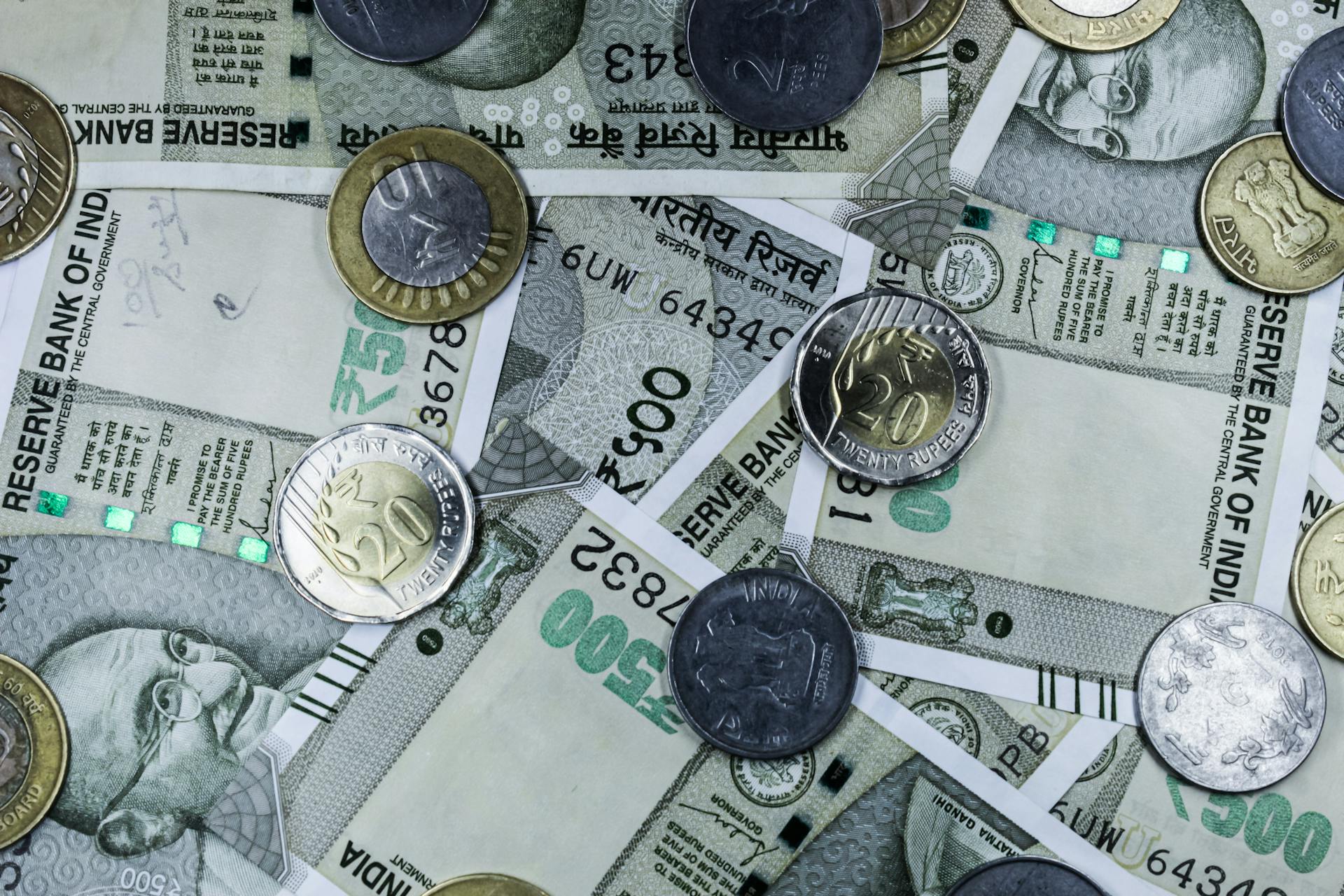
Masala bonds have been a game-changer for India's financial growth, providing a much-needed lifeline to the country's infrastructure and industry sectors.
In 2014, the Reserve Bank of India (RBI) allowed foreign companies to issue rupee-denominated bonds in India, marking the beginning of the masala bond era.
This move was a significant step towards deepening India's capital markets and reducing its reliance on foreign currency loans.
A fresh viewpoint: Foreign Currency Convertible Bonds
What Are Masala Bonds?
Masala Bonds are essentially debt instruments used to raise money from foreign investors in local currency. They're a way for Indian entities to tap into international funding.
These bonds are issued outside India in rupees, which is the local currency. This unique feature sets them apart from other types of bonds.
The framework for issuing rupee bonds overseas falls within the External Commercial Borrowings policy. This policy provides a regulatory structure for such transactions.
Consider reading: Can U Have More than One Life Insurance Policy
What Is?
Masala Bonds are debt instruments used to raise money from foreign investors in local currency. They are a way for Indian entities to access global capital markets.
These bonds are issued outside India and are denominated in rupees, the local currency of India. The framework for issuing these bonds overseas falls under the External Commercial Borrowings policy.
They allow Indian companies to tap into foreign capital, which can be used to finance their projects and operations. This can be a useful tool for companies looking to expand their business.
Readers also liked: Real Estate Asset Management Companies
Origin of the Name
The name "masala bonds" might seem like a curious choice, but it actually has a story behind it. The term 'Masala' was used by IFC to evoke the cuisine and culture of India.
The name "masala" refers to the blend of spices used in Indian cooking, and in this case, it's a blend of international investors and Indian markets.
Masala bonds are a type of bond that makes investors bear the risk, unlike dollar bonds where the borrower takes the currency risks.
A fresh viewpoint: What Can Be Used as Collateral for a Bond?
Benefits and Drawbacks
Masala bonds offer several benefits that make them an attractive option for both issuers and investors. They provide a new avenue for international investors to invest in the Indian market without the need for FPI registration, reducing paperwork and costs.
Readers also liked: Private Equity for Retail Investors
One of the main advantages of masala bonds is that they allow Indian businesses to borrow capital at low interest rates, unaffected by the rupee's decline in value. This is especially beneficial for Indian businesses looking to expand their operations.
Masala bonds also offer a simple way to familiarize foreign investors with the Indian rupee, expanding its market reach. By issuing masala bonds, Indian businesses can tap into a wider investor base and potentially lower their borrowing costs.
However, masala bonds also have some drawbacks. One of the main limitations is that the money obtained from these bonds can only be used for specific purposes, such as building low-cost housing developments or cohesive townships. This restriction may limit the effectiveness of masala bonds in achieving their primary objective.
Another disadvantage of masala bonds is that they come with a currency risk for investors, who bear the risk of fluctuations in the rupee's value. This can potentially deter some international investors from buying these bonds.
Here are some of the key benefits and drawbacks of masala bonds:
Benefits:
- Reduced currency exchange risk for the issuer
- Access to a wider investor base
- Potentially lower borrowing costs compared to domestic markets
- Opportunity for investors to gain exposure to the Indian economy without currency risk
Drawbacks:
- Currency risk transferred to investors
- Potentially higher interest rates due to this risk
- Market limitations due to the niche product
- Regulatory and compliance challenges
- Impact on Indian economy due to economic downturns or instability
How They Work
Masala bonds work by allowing Indian entities to issue rupee-denominated bonds in international markets. This means foreign investors can buy these bonds, lending money in rupees to the issuer.
The issuer repays the principal and interest in rupees, which mitigates currency exchange risks for the issuer. This is a significant advantage for Indian entities.
Foreign investors buy masala bonds, lending money in rupees to the issuer. This helps Indian entities raise capital or long-term funds.
The RBI has given Indian banks the go-ahead to issue masala bonds. This will help develop the market of rupee-denominated bonds overseas.
Issuance of masala bonds will provide an additional avenue for Indian banks to raise capital or long-term funds. This is a key benefit for banks with huge capital needs.
Banks' masala bonds will take care of their huge capital needs. This is a direct result of the RBI's measures for the development of the fixed income and currency markets.
Recommended read: How Do You Get Angel Investors
India and Masala Bonds
Low interest rates in major currencies like the US dollar, pound sterling, euro, and yen have created a favorable environment for Indian companies to raise funds via masala bonds.
The Reserve Bank of India (RBI) has given Indian banks the go-ahead to issue masala bonds, which will help develop the market of rupee-denominated bonds overseas and provide an additional avenue for Indian banks to raise capital/long-term funds.
India's masala bonds are gaining popularity due to global economic uncertainty, including Britain's decision to leave the European Union (EU), making it an attractive opportunity for overseas investors.
The RBI has also relaxed guidelines for corporate bond markets, making it easier for Indian banks to issue masala bonds and meet their huge capital needs.
Here are some benefits of masala bonds for India:
- Internationalization of the Indian rupee
- Fall in foreign currency-denominated external commercial borrowings (ECB)
- Development of domestic bond markets
- Creation of a new venue for retail investors
India
India is taking advantage of low global interest rates to raise funds through masala bonds. These bonds are issued in Indian rupees but listed overseas, making it easier for international investors to participate.
Interest rates in major currencies like the US dollar, pound sterling, euro, and yen are at historic lows, making it a great time for Indian companies to issue masala bonds. This can help them raise funds at a lower cost.
The Reserve Bank of India (RBI) has given Indian banks the green light to issue masala bonds, which will help develop the market for rupee-denominated bonds overseas. This will also provide an additional avenue for Indian banks to raise capital and long-term funds.
India's first International Exchange at GIFT city is set to start trading from January 16, offering equity, currency, and interest rate derivatives. This will provide a platform for Indian companies to list their masala bonds and attract international investors.
Here are some benefits of masala bonds for India:
- Helps to internationalize the Indian rupee
- Reduces foreign currency-denominated external commercial borrowings
- Develops domestic bond markets
- Creates a new venue for retail investors
The RBI's move to relax guidelines for corporate bond markets has been hailed by analysts and market participants. This is expected to boost the growth of masala bonds in India.
India's Diplomacy Effectiveness
India's Diplomacy Effectiveness is a crucial aspect to consider when evaluating the impact of masala bonds. Most masala bonds are listed in the London Stock Exchange.
This international listing can aid India's geoeconomic goals. However, India may not be leveraging the rupee's internationalisation to its full potential.
The emergence of masala bonds as a funding vehicle for Indian companies has been a significant development.
You might like: How to Buy Crypto Coins in India
Examples and Issues
Masala bonds have been issued by various organizations, including the International Finance Corporation (IFC), which issued the first-ever Masala bonds in 2014. They were valued at 10 billion Indian rupees and had a maturity of ten years.
The IFC also issued Green Masala bonds in 2015, raising 3.15 billion rupees for private sector investments in climate change.
Here's a list of notable Masala bond issuances:
- 2014: IFC issued the first-ever Masala bonds, valued at 10 billion rupees.
- 2015: IFC issued Green Masala bonds, raising 3.15 billion rupees.
- 2016: HDFC successfully raised ₹3000 crore through Masala bonds.
- 2016: NTPC issued corporate green Masala bonds, valued at ₹2000 crore.
- 2019: Kerala Infrastructure Investment Fund Board (KIIFB) issued ₹2,150 crore Masala bonds on the London Stock Exchange.
- 2021: Asian Development Bank listed masala bonds with a maturity of ten years, valued at ₹300 crore.
Examples
Examples of Masala bonds include the International Finance Corporation (IFC) issuing the first-ever Masala bonds with a maturity of ten years and ten billion Indian rupees in 2014. This was a significant milestone in the development of the Masala bond market.

The IFC also issued the first-ever Green Masala bonds in 2015 to raise 3.15 billion for private sector investments in climate change. The success of these bonds paved the way for future issuances.
HDFC successfully raised ₹3000 crore through the issuance of Masala bonds in 2016, making it the first Indian business to do so. This achievement marked a new era in corporate fundraising.
The NTPC issued the first corporate green Masala bonds valued at ₹2000 crore in 2016. This was a significant step towards reducing the company's carbon footprint.
The Kerala Infrastructure Investment Fund Board (KIIFB) became the first sub-sovereign body in India to have access to the international bond market by issuing ₹2,150 crore on the London Stock Exchange in 2019. This achievement opened up new opportunities for sub-sovereign entities.
The Asian Development Bank listed masala bonds with a maturity of ten years, with a total value of ₹300 crore, in 2021. This marked a significant milestone in the development of the Masala bond market.
Curious to learn more? Check out: Rbi Sovereign Gold Bond
Issues

One major issue with Masala Bonds is the sustainability of financing via this instrument, as investors are cautious about taking on currency risks from emerging markets.
According to Moody, investors are hesitant to take on these risks, which can make it difficult for issuers to secure funding.
The RBI's periodical rate cuts have also made Masala Bonds less appealing to investors, reducing their attractiveness as an investment option.
Higher taxes have further undermined the utility of Masala Bonds, making them less desirable for investors.
Exchange rate risks are still borne by the issuing economy, which can lead to pressure on the Indian rupee if foreign investors redeem their holdings in bulk due to changing international interest rates or deteriorating macroeconomic fundamentals in India.
Here are some key challenges associated with Masala Bonds:
- Sustainability of financing due to investor caution
- Less appealing due to RBI's periodical rate cuts
- Undermined by higher taxes
- Exchange rate risks borne by the issuing economy
HDFC Seeks More Deals
HDFC aims to raise more money via "masala" bonds after making its debut issue last month.
The bank's executives said HDFC has appetite for more "masala" bond deals.
Explore further: Hdfc Demat Account App

HDFC has already raised Rs 5,000 crore through masala bonds, and the Reserve Bank of India (RBI) has granted it permission to raise another Rs 3,000 crore from the newly emerging route.
This move is part of HDFC's plan to expand its fundraising options and tap into the growing market for rupee-denominated bonds overseas.
p.article.sections.frequentlyAskedQuestions
Which bank issued masala bonds?
The World Bank-backed IFC issued the first Masala bond. It raised ₹10 billion in 2014 to fund infrastructure projects in India.
Who regulates masala bonds in India?
The Reserve Bank of India (RBI) regulates Masala Bonds in India, allowing eligible corporates and Indian banks to issue Rupee denominated bonds overseas.
What is the most popular market for masala bonds?
The London Stock Exchange is the most popular market for masala bonds, where Indian companies such as Housing Development Finance Corp., Yes Bank, and the Railways have successfully raised funds.
p.article.featuredImages pexels.com



